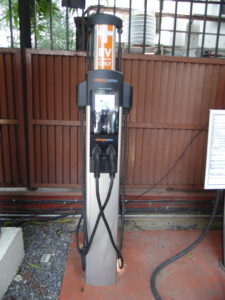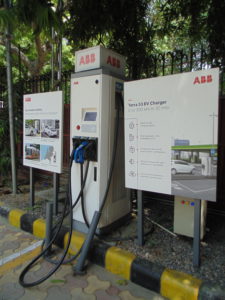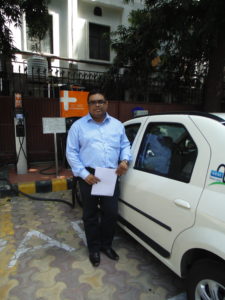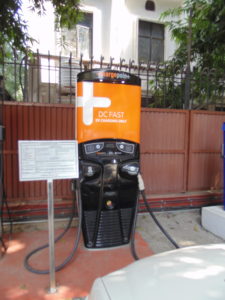In a country where e-vehicles have failed to take off so far, the NITI Aayog staff’s use of e-Verito gives the sector a boost, and points towards what is needed
NITI Aayog, the government’s think tank, which has been working to get a comprehensive framework for electric vehicles, has four such vehicles for its staff.
Under the government’s initiative to replace five lakh cars used by the government to e-vehicles, the first tender by Energy Efficiency Services Ltd (EESL) was won by TATA motors for 10,000 cars. It was later made to 5,000 cars with the other half given to Mahindra & Mahindra.
Through this, every government department has been handed some cars to use. One of those using the cars for the past three months is Avik Sarkar, OSD at the Aayog’s Data Analytics. He says he feels great to be riding a green vehicle. “People complain about the pickup” of electric vehicles, which supposedly keeps them from buying one, but in the city, he points out, one does not require the car to go from 0 to 100 within seconds. “The present capabilities work just fine,” he says.

Another positive he points at and emphasises on is the quietness of the car itself, “There’s no blaring sound”. And while many complain about the range of an electric vehicle, he found his e-Verito capable enough to take him around the city for a day. “I have gone from my office in central Delhi to Gurgaon and back — a total of 70-80 km — and it has never stopped.” He does admit though, that for those looking to go beyond, an electric vehicle would be a problem.
Two interns at NITI Aayog —Hemant and Aditi — thus believe that the first priority for a push in green cars should be of hybrid cars, which basically have electric capabilities while not forgoing the safer bet of having a petrol run engine.
It is clear that even a satisfied user such as Sarkar finds that the problem lies in the lack of charging points. NITI Aayog’s parking space is dotted with electric chargers and one super charger which can give a full charge to an e-vehicle in three hours, but not everyone has such a facility in their offices, forget an easy outlet in their homes.
The bulkiness of a charging unit for city dwellers seems more than a headache, especially as most live in multi-storey homes and not independent set-ups with a driveway.

So, the question is, will India be able to soon join others in driving e-vehicles into the popularity zone? With the government aiming to have 15% sales from pure electric vehicles in the next five years, it looks like the most important task at hand would be to create the infrastructure which will provide charging points for owners, making the idea of owning an electric car much more attractive.
Take the example of Norway. Its electric vehicle use has grown exponentially. While this could be put down to the number of incentives provided to the users — which NITI Aayog suggests should be introduced in India — it’s also a fact that using them is easy when your city is dotted with chargers. Oslo has 2,000!
The starting point to this is a plan, which the government has proclaimed it has. In May, it proposed to set up charging stations for electric vehicles every three kilometres in cities, and every 50 km on busy national highways.
The fact is that if you give something that would be cheaper to users, then they would grab it. That can also be seen with the popularity of CNG vehicles. Motorist Shubhi says that she drives 60 km every day which costs about Rs 150 in her CNG car. If it were an entirely petrol-driven car then that same ride, if the mileage is 15 km per litre (which now costs Rs 82 per litre), would make a day’s travel cost more than double the amount at Rs 328.
The electric cars we currently have, don’t get the best of reviews. The most prominent example for this is the TATA’s electric Tigor. After being delivered to various government officials, under the EESL tender, many complained that the cars range was ‘inadequate’.

The delivery of 350 cars under the first phase, saw officials claiming it drove only about 80 km on a full charge. Tata refutes the claim by saying the distance its full charge gives is at 130 km, which is “adequate to meet the daily requirement”.
It also says that while they could make the range even better at 250 km, it would mean the battery cost going up to Rs 7 lakh, which is “completely inaccessible for the majority of the Indian customers”.
And they have a point. The NITI Aayog in its report on e-vehicles highlighted that in India, 12% automobiles in use were economic cars — those costing less than Rs 10 lakh. This is much higher than the premium cars users — cars costing over Rs 10 lakh — which are at just 2%.
Matching the excellence of a premium e-vehicle, say a Tesla, looks a long way away, forget about being affordable. A Tesla Model 3 — introduced as the company’s mass market car —claims to give a mileage of about 350 km on a single charge. It costs around Rs 50 lakh, including the 100% import duty. What then is obvious is the need for home-grown cars that can match, or come close to the drive of a Tesla, and give people the mileage that a fuel guzzling sedan or SUV would give.

Maybe Maruti Suzuki will be able to help reach out to more car owners. After all, it is known to give quality with a price that is well received by the average Indian buyer. The largest car manufacturer in the country, and to which buyers remain the most loyal, has some good news and hope for the future. It announced testing of 50 electric cars, in collaboration with Toyota, from October. It plans to introduce its EVs in 2020 and also open a battery plant in the country to produce Lithium Ion batteries from the same year.
Making a car cheap enough to become attractive for the greater swathe of buyers is necessary, but without compromising on performance. The government’s task at hand is most importantly, to provide the infrastructure.





